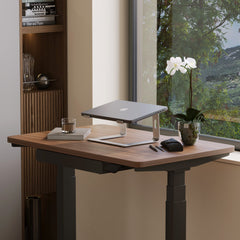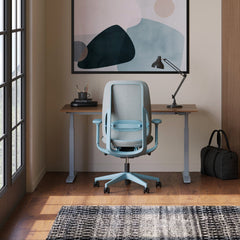Get 10% off your first order
Find the office furniture that’s designed to match your style, comfort, and needs perfectly. Subscribe
The Shape of Focus: How Furniture Design Influences Remote Work Habits

Visit quiz page to see how we makes it easy to create an inspiring workplace


Working from home gives flexibility, but it also tests discipline. The way your workspace looks, feels, and functions directly impacts how well you think and perform. Creating a productive setup doesn’t mean spending more—it’s about designing a space that supports your focus and well-being every day.
Let’s explore how simple design choices and ergonomic furniture can help you work smarter, stay comfortable, and make the most of your home environment.
Your surroundings influence your energy and creativity. A cluttered or uncomfortable space can lead to distraction and fatigue, while a structured environment helps you think clearly.
Keep only essentials on your desk.
Balance natural and artificial light.
Choose neutral or calming tones.
Maintain consistent airflow and temperature.
A clear environment sets the stage for mental clarity.
Before adding décor, think about how you work best. Do you focus better facing a wall or a window? Does background sound motivate you or distract you?
Place your desk where distractions are minimal.
Use soft partitions for focus if you share space.
Keep your daily tools within arm’s reach.
Separate zones for work and relaxation.
Purposeful design creates invisible boundaries that help you switch on and off with ease.
Your desk isn’t just a surface—it’s your workspace anchor. Its height, texture, and layout affect posture and energy.
A versatile choice like the Small Standing Desk Connecticut allows you to shift naturally between sitting and standing, promoting better circulation and balance.
|
Feature |
Benefit |
Purpose |
|
Adjustable height |
Promotes movement |
Reduces fatigue |
|
Neutral tone |
Calms the eyes |
Improves focus |
|
Smooth finish |
Comfortable to touch |
Encourages long use |
|
Compact shape |
Fits small areas |
Saves space |
A thoughtful desk layout helps you feel centered and capable throughout the day.
Long hours of sitting slow your body’s rhythm and focus. Incorporating movement into your routine keeps both energy and creativity flowing.
A standing desk supports active posture without disrupting workflow.
Stand for short intervals every hour.
Stretch wrists, shoulders, and back regularly.
Walk around during breaks or calls.
Alternate between sitting and standing for balance.
Movement transforms work from static to fluid—and focus follows naturally.

A productive home workspace blends aesthetics with ergonomics. Furniture should adapt to your habits, not restrict them.
A clean, versatile office desk supports organization while maintaining visual calm.
|
Item |
Design Focus |
Benefit |
|
Desk chair |
Lumbar support |
Reduces back tension |
|
Lighting |
Adjustable |
Adapts to mood |
|
Storage |
Hidden compartments |
Keeps surface tidy |
|
Accessories |
Minimal |
Prevents clutter |
Comfort and clarity go hand in hand when furniture is chosen with care.
A workspace psychology study reveals that workspace layout and design influence mood, motivation, and concentration. Even subtle changes—like color or organization—can alter performance.
Organized environments improve mental stability.
Personalization increases comfort and belonging.
Natural textures enhance calm and focus.
Flexible setups reduce mental fatigue.
Science supports what we feel daily: our environment shapes our performance.
Lighting affects how you perceive time and focus. Poor lighting strains the eyes and dulls energy, while balanced illumination fosters clarity.
Use a mix of natural and soft artificial light.
Position your monitor perpendicular to windows.
Choose warm bulbs for comfort and focus.
Keep lighting consistent across your workspace.
Light isn’t decoration—it’s a performance tool.
A workspace that feels personal motivates consistency. Add elements that reflect who you are but keep them simple to avoid sensory overload.
Frame one inspiring photo or artwork.
Add a small plant for color and balance.
Use textures that feel natural and grounding.
Keep decorative elements limited to 3–4 items.
Your workspace should inspire—not overstimulate.
Even at home, teamwork matters. A quad workstation design offers flexibility for couples or roommates who share a workspace.
Maintain clear personal zones.
Use soft dividers for visual separation.
Balance light evenly between sections.
Keep shared storage accessible for both.
A home office can encourage teamwork when structure supports communication.
Distraction control is an ongoing part of productivity. While total silence can feel unnatural, excessive noise harms focus.
|
Source |
Fix |
Result |
|
Background noise |
Use soft music or white noise |
Improves rhythm |
|
Clutter |
Implement daily reset routine |
Clears mind |
|
Notifications |
Schedule screen breaks |
Enhances focus |
|
Visual chaos |
Stick to consistent colors |
Calms attention |
Control your environment, and your focus will follow.
Not every home allows a dedicated office, but that doesn’t mean you can’t create a workspace that functions.
A six-person workstation desk setup can transform shared spaces into multifunctional work hubs that remain tidy and flexible.
Use foldable dividers for privacy.
Keep personal tools stored after work.
Schedule quiet hours for focused time.
Make the area dual-purpose but structured.
Good design works even when space is limited—it’s about planning, not size.
Productivity thrives in spaces that evolve. Small changes in texture, layout, or lighting keep the environment stimulating without being distracting.
Reorganize your desk quarterly.
Change décor with the seasons.
Evaluate what no longer serves your workflow.
Keep a minimal, functional aesthetic.
Refreshing your workspace occasionally keeps creativity flowing and focus strong.

A productive home workspace is more than a room—it’s a reflection of how you want to feel at work. When design, comfort, and function align, productivity becomes effortless.
Movement builds momentum.
Comfort improves focus.
Simplicity drives consistency.
Personalized design fuels motivation.
Your workspace should support your goals, nurture your energy, and inspire your best work every single day.

The Shape of Focus: How Furniture Design Influences Remote Work Habits

Choosing a Chair for Hardwood or Tile Floors

Gaming vs Executive Chairs for Remote Workers
Get 10% off your first order
Find the office furniture that’s designed to match your style, comfort, and needs perfectly. Subscribe
Leave a comment